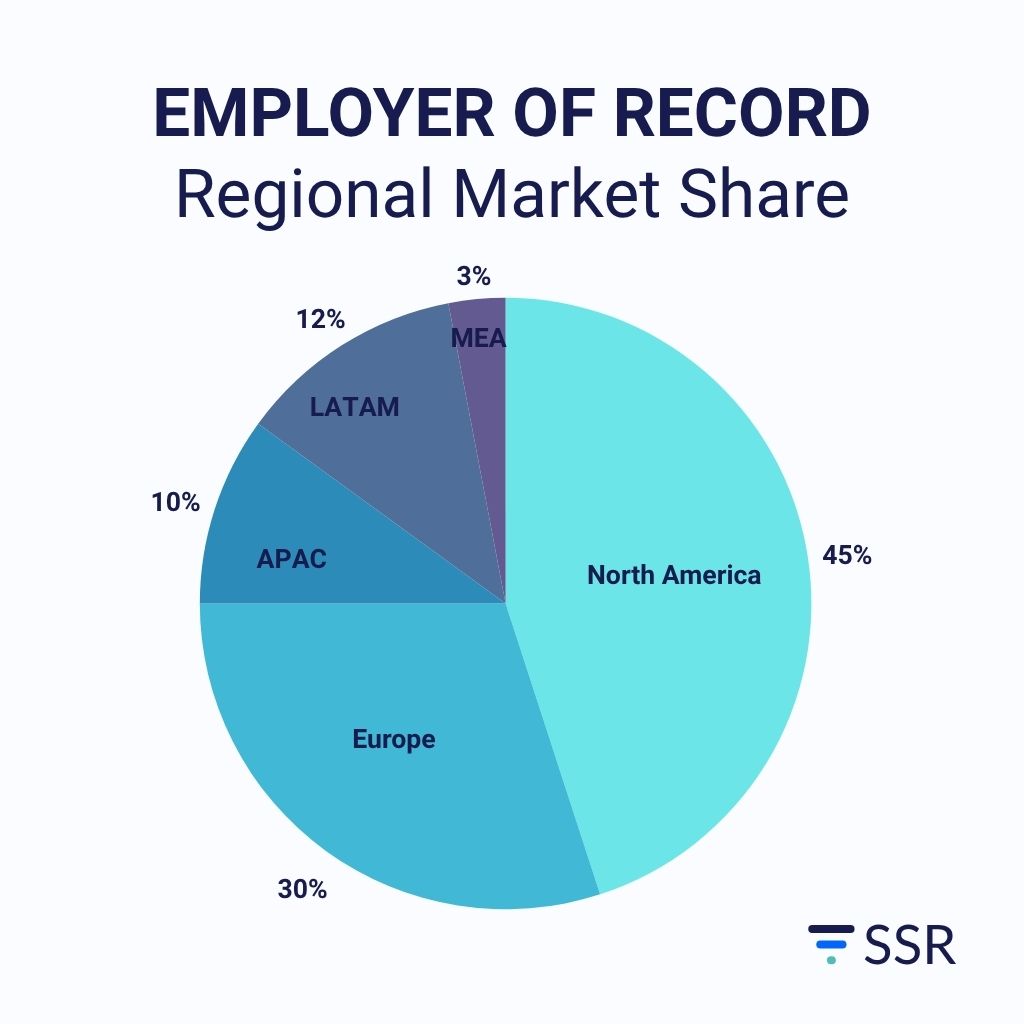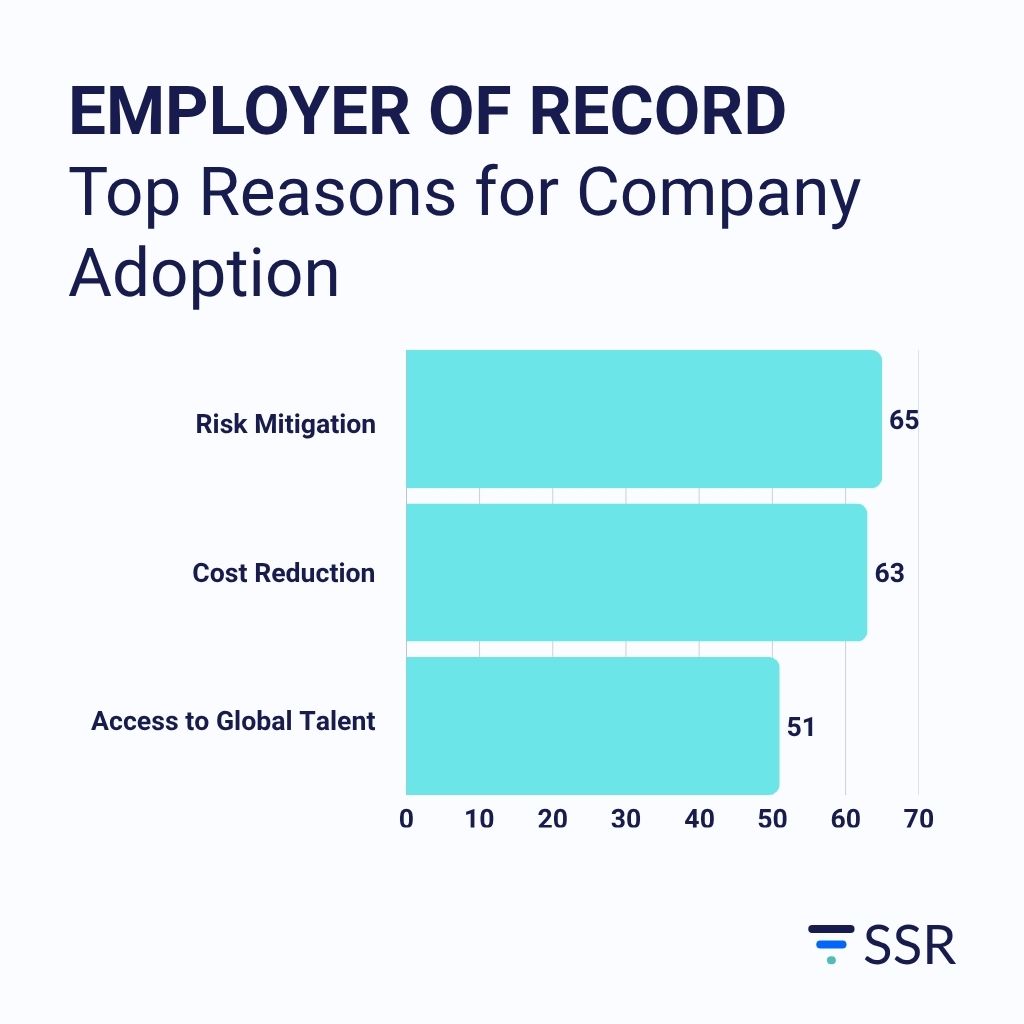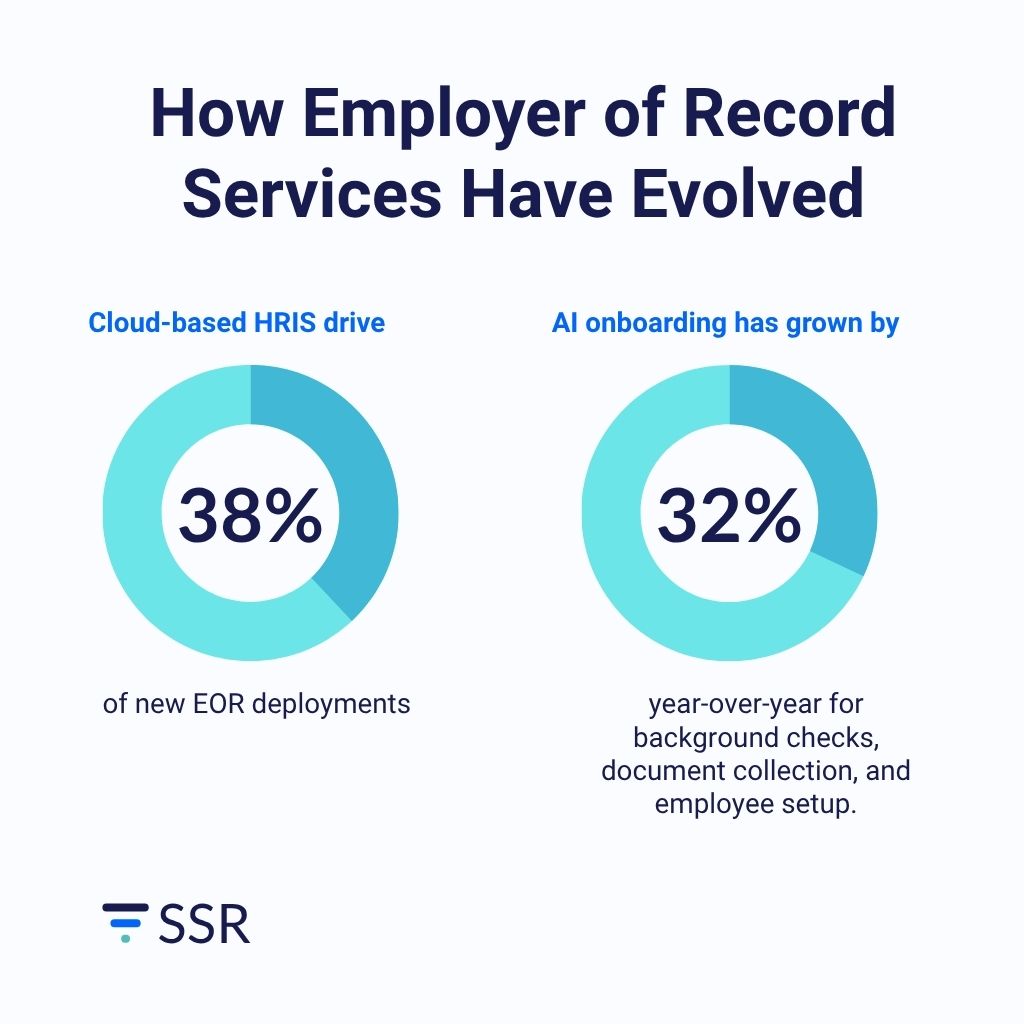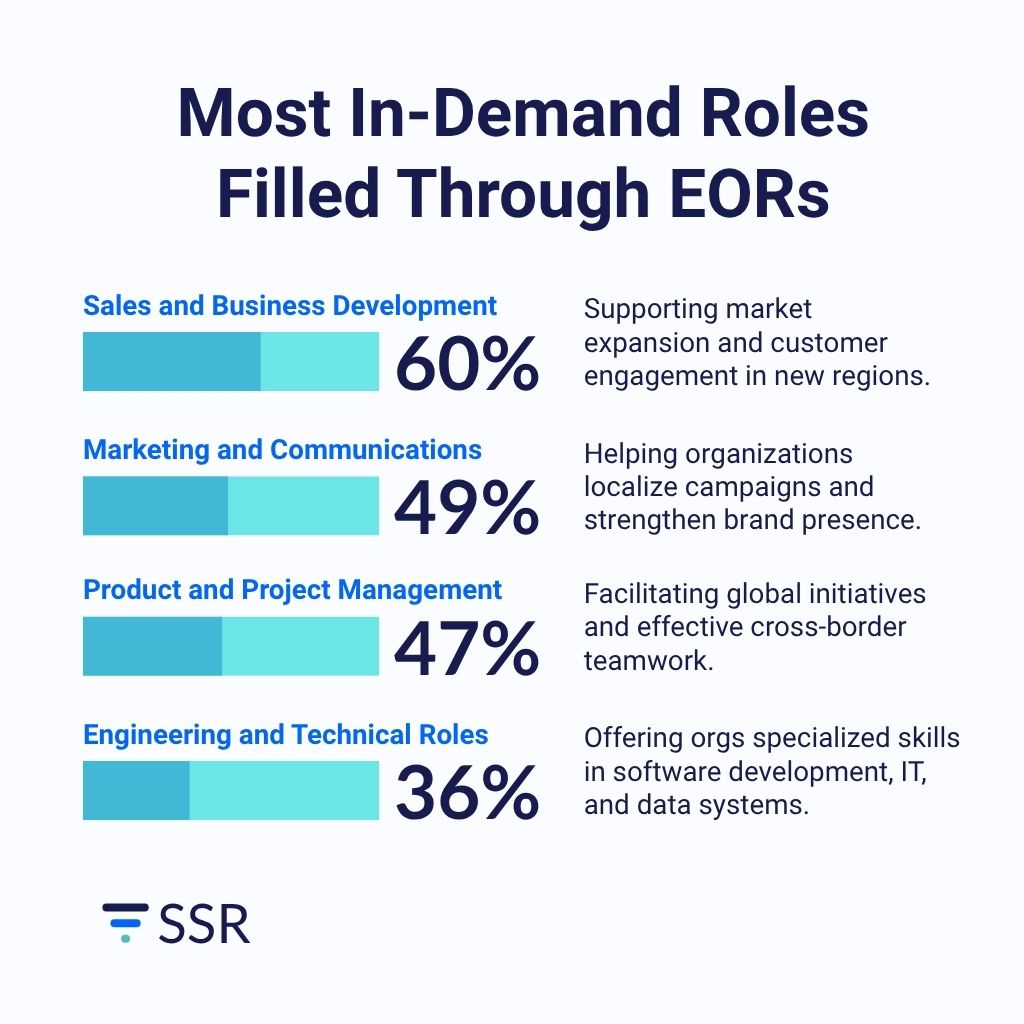As businesses expand across borders faster than ever, Employer of Record (EOR) services have emerged as a strategic solution for managing global workforces of companies big and small. By handling payroll, taxes, compliance, and contracts in countries where companies lack a local entity, EORs make global hiring both legal and effective.
This article compiles key statistics and trends in the employer of record sector, including growth metrics, emerging technologies, regional shifts, and expert predictions that are shaping the landscape.
Employer of Record Market Size
The global market for Employer of Record (EOR) services is experiencing rapid growth. One source, Business Research Insights, the EOR platform segment is estimated to grow from $5.6 billion in 2025 to $10.46 billion by 2035, increasing by 6.8% each year. Another consulting firm, Exactitude Consultancy, predicts even stronger growth for the entire EOR market, forecasting it will reach $25 billion by 2034, with an annual growth rate of 9.5%.
EOR Regional Market Share
- North America leads the market, making up about 45% of the total revenue worldwide. Its dominance is fueled by a mature HR tech landscape, an established outsourcing culture, and widespread adoption of remote work. Within North America, an EOR in Canada enables U.S. companies to hire seamlessly across provinces by managing CRA payroll remittances, CPP and EI contributions, and bilingual employment compliance requirements.
- Europe follows with about 30% market share, where complex and varied labor regulations across EU member states drive strong demand for outsourced compliance solutions. In markets such as the United Kingdom, an EOR in the UK helps companies manage strict employment and tax regulations, including PAYE and National Insurance, allowing smoother expansion without setting up a local entity.
- Asia-Pacific (APAC) is the fastest-growing region, with an expected 10% CAGR through 2034, supported by rapid hiring activity in India, China, and Southeast Asia. In this region, particularly in Dubai and Abu Dhabi, an EOR in the UAE plays a key role in helping companies stay compliant with visa sponsorships, end-of-service gratuity rules, and free-zone employment regulations.
- Latin America is also becoming a popular area for EOR growth, expected to grow at about 12% annually. This is mainly because companies are moving jobs closer (nearshoring) and there's more need for tech and service workers.
- While currently smaller markets, the Middle East and Africa offer promising long-term growth potential. This is driven by their evolving economies and a tech-savvy younger population.

Statistics on Why Companies Use an Employer of Record
More and more organizations are using employer of record services to hire international workers, reported Atlas. Specifically, 41% of teams use EORs, and nearly half (49%) plan to start using them. The main reasons for this trend are:
- Risk Mitigation: 65% use EORs to reduce regulatory and compliance risks.
- Cost Reduction: 63% use them to lower the financial cost of setting up and maintaining local entities.
- Access to Global Talent: 51% use them to hire specialized skills by expanding their search beyond domestic borders.

As talent shortages continue across many regions, companies are increasingly using EORs to hire skilled professionals wherever they are located. This approach allows them to onboard employees, such as software engineers in Southeast Asia or sales teams in Latin America, while staying compliant with local employment laws and regulations.
When selecting new markets, organizations focus on three main factors:
- Availability of skilled labor (40%)
- Overall employment cost (30%)
- Time zone compatibility with primary business operations and key stakeholder locations (28%)

Employer of Record Market Segmentation
While every EOR shares the core responsibility of enabling companies to legally hire international employees, their operations are based on two structurally different models.
- Aggregator Model (68% market share per Valuates): In this setup, an EOR partners with local companies or affiliates in each country to act as the legal employer. This model allows providers to expand coverage quickly across multiple regions. However, service quality and compliance processes may vary between partners, since each local entity operates somewhat independently.
- Wholly-Owned Model: Here, the EOR directly owns and manages its own legal entities in each country. This approach offers greater consistency, data control, and standardized compliance practices. It is typically preferred by larger enterprises with high-volume hiring or stricter security requirements.

The Rise of Employer of Record Services as a Compliance Solution
Compliance has become the single biggest reason companies turn to employer of record services. Managing labor laws, tax regulations, and employment requirements across multiple countries is becoming increasingly complex, and most HR teams lack the local expertise to handle these requirements effectively.
The same Atlas data also highlights just how widespread this challenge has become:
- 86% of HR leaders identify compliance with international labor laws as their top global workforce challenge.
- 87% of companies planning expansion say that meeting local tax and employment regulations will be their hardest task in 2026.
- 74% of organizations already rely on external experts for international HR guidance, and 51% specifically seek help with compliance and market-entry support.

How Employer of Record Companies Have Evolved
What was once a largely manual, service-based process is now evolving into a software-driven model that blends automation, analytics, and human expertise.
According to the cited Business Research Insights, modern EOR platforms increasingly operate as integrated HR and payroll systems. Most now use a hybrid model that combines AI and software to handle repetitive tasks while human specialists ensure legal accuracy and strategic alignment.
- Cloud-based HRIS now accounts for approximately 38% of new EOR deployments, reflecting the demand for scalable and accessible solutions.
- AI-driven onboarding has grown by 32% year-over-year, streamlining background checks, document collection, and employee setup.
- AI-powered compliance tools have improved error detection by around 29%, helping prevent costly regulatory mistakes before they happen.
- Blockchain technology is also emerging as a secure method for verifying employee identities and managing sensitive cross-border data.

Regulatory and Legal Trends Reshaping the EOR Market
The growing complexity of global labor and tax regulations is both a challenge for businesses and a key driver of employer of record adoption. As employment laws evolve across jurisdictions, EOR providers have become critical partners in helping organizations maintain compliance and mitigate risk.
Evolving Employment Laws
Countries continue to update labor frameworks to reflect the realities of remote and flexible work:
- Austria: Effective January 1, 2025, Austria implemented a comprehensive legal framework for remote work via the Teleworking Act (2024). This legislation provides clear protections for employees, mandates equipment compensation, and offers financial and tax incentives for businesses.
- Singapore: Updates to the Tripartite Guidelines on Flexible Work Arrangement Requests (2024) now give employees a formal right to request flexible arrangements, emphasizing fair consideration by employers.
- European Union: The EU Framework Agreement on Telework is reshaping how cross-border remote employees are covered for benefits and insurance.
Tax authorities worldwide are also tightening oversight of cross-border employment. New interpretations of “permanent establishment” under the OECD Model Tax Convention (Article 5) and its 2021 commentary have increased the risk of unintended tax liability when companies engage workers abroad.
As global data privacy standards evolve, employee data protection has become central to HR compliance. Key frameworks include:
- European Union: The General Data Protection Regulation (GDPR) sets strict rules on personal data handling and cross-border transfers.
- India: The Digital Personal Data Protection Act regulates how companies collect, store, and process employee data in and outside India.
- Brazil: The Lei Geral de Proteção de Dados (LGPD) aligns closely with GDPR principles and applies to all data processed within Brazilian territory.
International treaties are also reshaping how employment, taxation, and benefits apply to workers operating between countries. For instance, the Netherlands-Germany Tax Treaty (2023 revision) clarified employment, taxation, and benefits for cross-border workers, particularly those in hybrid or remote roles.
Most In-Demand Roles Filled Through EOR Services
Recent data shows that the most common roles filled through EORs include:
- Sales and Business Development (60%) – supporting market expansion and customer engagement in new regions.
- Marketing and Communications (49%) – helping organizations localize campaigns and strengthen brand presence.
- Product and Project Management (47%) – coordinating global initiatives and ensuring teams work effectively across borders.
- Engineering and Technical Roles (36%) – giving companies access to specialized skills in areas such as software development, IT, and data systems.
EOR providers make it possible to hire these professionals quickly and compliantly in different countries.

Statistics on Employer of Record Risks and Disadvantages
Although the market continues to grow rapidly, several EOR risks still challenge its broader adoption.
- High service costs can make EOR solutions less accessible for smaller businesses with limited budgets.
- Privacy and data protection regulations affect about 31% of providers, creating added complexity in managing employee information across borders.
- Worker classification ambiguity remains unresolved in roughly 27% of markets, leaving some uncertainty around how local authorities define employment relationships.
Despite these challenges, the benefits of using EOR services generally outweigh the risks. Companies value the ability to expand quickly, remain compliant in multiple countries, and manage global teams without setting up legal entities. For most organizations, EORs continue to represent a practical and efficient way to operate internationally with reduced risk and greater flexibility.
Top Employer of Record Companies
The global employer of record market is becoming more competitive as established providers expand their reach and new entrants introduce specialized offerings. The following are some of the key players. While the top five vendors account for about 47% of total market share, growing regional demand and niche use cases are driving continuous diversification.
Strategic alliances between global and local EOR providers are also becoming more common. These partnerships allow companies to offer wider coverage and deeper expertise in local compliance without the need for extensive in-house infrastructure.
- ADP acquired global compensation management software Pequity, contingent workforce management platform WorkForce Software, and workflow automation tool Sora
- G-P expanded its presence in the Asia-Pacific region through a major acquisition
- ADP and G-P partner as an effort to unify and simplify international HR and employment.
- Pebl entered Vietnam and Thailand to strengthen its coverage across Southeast Asia.
Employer of Record Trends: 2026 and Beyond
Considering the aforementioned market numbers and trends, it is evident that the EOR model has evolved from a simple solution for payroll and compliance into a vital mechanism for facilitating borderless work.
By 2035, analysts expect:
- EOR platform revenue to surpass 10 billion dollars.
- Service-based EOR operations to exceed 25 billion dollars in combined value.
As geopolitical conditions, regulatory frameworks, and talent mobility continue to shift, EORs will remain central to helping companies hire, manage, and retain employees worldwide. In a business environment where labor laws change more rapidly than corporate policies, EORs provide organizations with compliance and confidence.


























